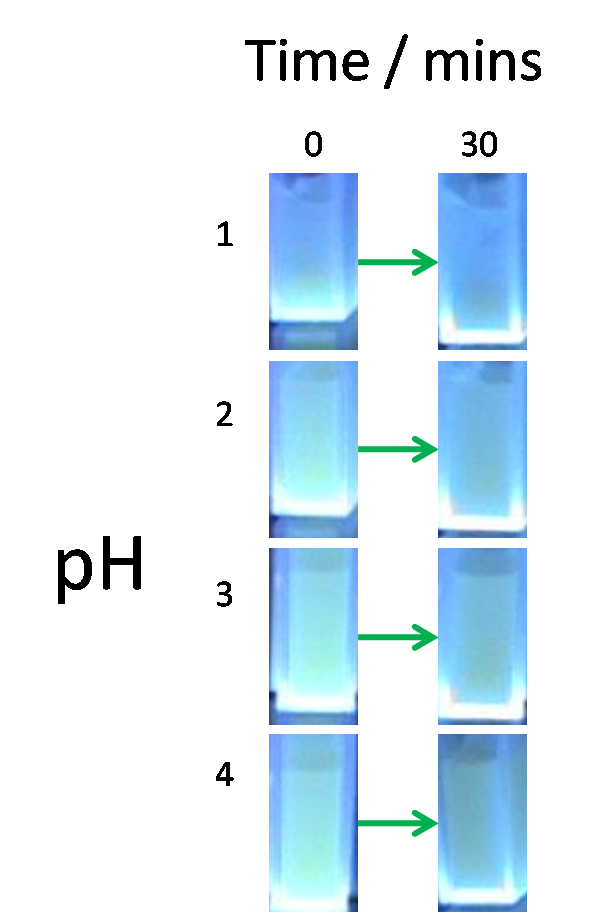Team:Imperial College London/M2
From 2009.igem.org
JamesField (Talk | contribs) (→E.coli and acid resistance:) |
JamesField (Talk | contribs) (→Phase 1:) |
||
| Line 72: | Line 72: | ||
Of these three organisms, <i>E.coli</i> was chosen as it is safe, easy to work with and possesses a broad range of acid resistance strategies. | Of these three organisms, <i>E.coli</i> was chosen as it is safe, easy to work with and possesses a broad range of acid resistance strategies. | ||
| + | |||
| + | ====<b>E.coli and acid resistance:</b>==== | ||
| + | |||
| + | [[Image:AcidBath.png|left|150px]] While <i>E.coli</i> has endogenous acid resistance pathways, colonisation of the gut is based on a "numbers approach". In essence, the majority of <i>E.coli</i> cells in a population do not survive passage through the stomach but the few that do are able to regenerate the population once in the intestine. | ||
| + | |||
| + | This point is illustrated one of our experiments shown by the image on the left. In this experiment, constitutive GFP producing <i>E.coli</i> cells were exposed to differing concentrations of acid for 30 minutes. The reduction in fluoresence is indicative of cell lysis and the subsequent acid-induced denaturing of GFP. | ||
| + | |||
| + | This experiment indicates that if we are to deliver a significant dose of a given polypeptide therapeutic past the stomach, it will be necessary to boost the natural acid resistance of <i>E.coli</i>. | ||
==<b>Phase 2:</b>== | ==<b>Phase 2:</b>== | ||
Revision as of 21:45, 19 October 2009

Please delete as completed.
Module 2 feedback from todays session:
1) Remind reader of constraints of the system - why we need protection.
2) More detail and add references. Keep it technical so understandable to all.
3) Justify use of CA & compare to the alternatives - say it meets our requirements.
4) Content is good - just need to restructure it.
5) Encapsulation triple hack - Why? Need to introduce this.
6) Results: Need pics of plates - CHARLES TO BRING IN CAMERA! Growth assay - tomorrow?!
7) Trehalose - need this but don't have data for freeze drying...
8) Remove finale - keep the arrow structure like the other pages
9) Why 42 degrees and when? Explain. Say once got enough protection... blah
10) Link all constructs to registry.
11) If no data exists - say that as the wiki is being frozen we haven't added the data but will have it in time for the Jamboree.
12) Have a rationale section.
13) Add what teams can reuse from this module.
14) Have a conclusion of the page at the end - couple of lines.
Contents |
 Module 2 - Encapsulsation
Module 2 - Encapsulsation
The E.ncapsulatior has been designed to be able to withstand the rigours of stomach acid and freeze drying. This is achieved by the synthesis of the exopolysaccharide colanic acid and the cryoprotectant trehalose.
The need for acid resistance:
To ferry polypeptides through the stomach, each of our microcapsules must withstand a heated protease–rich acid bath. Let there be no illusions, this is no mean feat. The stomach is a highly evolved microbe–mincer that few chassis have the potential to withstand. What is more, since our microcapsules are inanimate, we cannot rely on any of the active acid–resistance strategies that living bacteria are able to deploy.
To tackle this seemingly insurmountable problem we adopted a two phase approach.
Phase 1: Identify a suitable chassis with the genotypic potential for acid–resistance.
Phase 2:Manipulate endogenous acid resistance pathways to control the acid resistant phenotype.
Phase 1:
Our rationale for looking for natural sources of acid resistance is that it is easier to hack existing pathways than to transfer large numbers of genes into a different chassis with a dissimilar genetic background.
Based on natural sources of acid resistance, Lactobacillus, E.coli and B.subtilis were shortlisted as potential chassis.
Of these three organisms, E.coli was chosen as it is safe, easy to work with and possesses a broad range of acid resistance strategies.
E.coli and acid resistance:
While E.coli has endogenous acid resistance pathways, colonisation of the gut is based on a "numbers approach". In essence, the majority of E.coli cells in a population do not survive passage through the stomach but the few that do are able to regenerate the population once in the intestine.This point is illustrated one of our experiments shown by the image on the left. In this experiment, constitutive GFP producing E.coli cells were exposed to differing concentrations of acid for 30 minutes. The reduction in fluoresence is indicative of cell lysis and the subsequent acid-induced denaturing of GFP.
This experiment indicates that if we are to deliver a significant dose of a given polypeptide therapeutic past the stomach, it will be necessary to boost the natural acid resistance of E.coli.
Phase 2:
We hacked E.coli’s acid resistance module in three places to achieve the production of a safe acid resistant capsule.
Acid Resistant Polymer – Colanic acid: E.coli naturally produces a harmless acid–resistant polymer known as colanic acid. Colanic acid is a polymer of glucose, galactose and glucuronic acid. By tapping into the pathway that initiates colanic acid biosynthesis, we can turn on its production via the modulation of a transcription factor encoded by a gene called RcsB.
Safety – Biofilm prevention:
In nature, colanic acid acts as a binding agent between individual cells over which a biofilm can be formed. While colanic acid itself is harmless, biofilm formation is associated with a number of virulence factors. To prevent biofilm formation from occurring, we have tapped into a second pathway such that our cells become locked into colanic acid production. The gene responsible for preventing biofilm formation is a transcription factor encoded by a gene called YgiV.
Microencapsulation – Colanic acid tethering:
In nature, colanic acid is associated with but not attached to the cell surface. To facilitate whole cell encapsulation, we have modified a third pathway to fix the colanic acid to the surface of the cell. This involves the over–production of an enzyme called Rfal.
E.coli and acid resistance:
While E.coli has endogenous acid resistance pathways, colonisation of the gut is based on a "numbers approach". In essence, the majority of E.coli cells in a population do not survive passage through the stomach but the few that do are able to regenerate the population once in the intestine.This point is illustrated one of our experiments shown by the image on the left. In this experiment, constitutive GFP producing E.coli cells were exposed to differing concentrations of acid for 30 minutes. The reduction in fluoresence is indicative of cell lysis and the subsequent acid-induced denaturing of GFP.
This experiment indicates that if we are to deliver a significant dose of a given polypeptide therapeutic past the stomach, it will be necessary to boost the natural acid resistance of E.coli.
By 'hacking' E.coli’s endogenous acid resistance pathways in three places we induced the formation of a safe colanic acid microcapsule that protects against the harsh acidic conditions of the stomach. Without encapsulation, our polypeptides would be denatured and degraded by stomach acid and digestive proteases respectively.
 About induced acid resistance.
About induced acid resistance.
The Encapsulation Triple Hack:
Acid Resistance Results:
To characterise colanic acid encapsulation, we assembled the following testing constructs:
Freeze Drying Theory:
Freeze drying is the process by which a material is preserved via its dehydration at a very low temperature. Freeze drying our chassis would slow the decomposition of the polypeptide of interest and prevent the growth of any contaminants. Unfortunatly, freeze drying can seriously damage cell membranes and denature the internal polypeptides. To prevent this from occuring we have decided to upregulate the biosynthesis of the cryoprotectant trehalose. The genes OtsA and OtsB are required for trehalose production.
 About freeze drying & trehalose biosynthesis.
About freeze drying & trehalose biosynthesis.
Freeze Drying Results:
To characterise the protective effect of trehalose against freeze drying, we assembled the following testing constructs:
Unfortunatly, we did not have time to ligate together both OtsA and OtsB and were therefore unable to do any functional assays.
Module 2 Contents





 "
"














